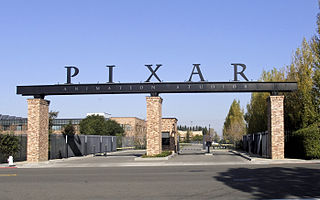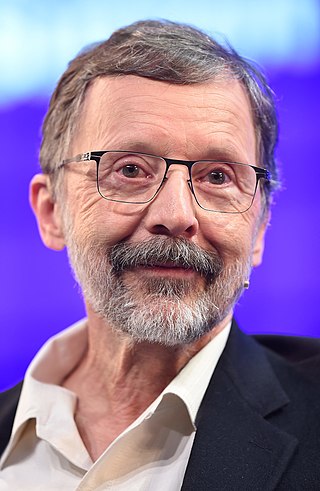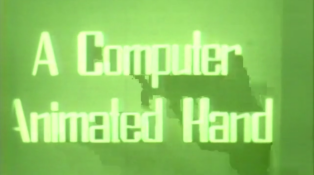
Pixar Animation Studios, known simply as Pixar, is an American animation studio based in Emeryville, California, known for its critically and commercially successful computer-animated feature films. Since 2006, Pixar has been a subsidiary of Walt Disney Studios, a division of Disney Entertainment, a segment of the Walt Disney Company.

Edwin Earl Catmull is an American computer scientist and animator who served as the co-founder of Pixar and the President of Walt Disney Animation Studios. He has been honored for his contributions to 3D computer graphics, including the 2019 ACM Turing Award.
The Computer Graphics Lab is a computer lab located at the New York Institute of Technology (NYIT), founded by the late Dr. Alexander Schure. It was originally located at the "pink building" on the NYIT campus. It has played an important role in the history of computer graphics and animation, as founders of Pixar and Lucasfilm, including Turing Award winners Edwin Catmull and Patrick Hanrahan, began their research there. It is the birthplace of entirely 3D CGI films.
The Works is a shelved animated feature film, partially produced from 1979 to 1986. If it had been finished as intended, it would have been the first film that was entirely 3D computer-animated. It included contributions from individuals who would go on to work at digital animation pioneers Pixar and DreamWorks Animation.

Luxo Jr. is a 1986 American animated short film produced and released by Pixar. Written and directed by John Lasseter, the two-minute short film revolves around one larger and one smaller desk lamp. The larger lamp, named Luxo Sr., looks on while the smaller, "younger" Luxo Jr. plays exuberantly with a ball to the extent that it accidentally deflates. Luxo Jr. was Pixar's first animation after Ed Catmull and John Lasseter left the Lucasfilm Computer Division. The film is the source of Luxo Jr., the mascot of Pixar.

The Pixar Image Computer is a graphics computer originally developed by the Graphics Group, the computer division of Lucasfilm, which was later renamed Pixar. Aimed at commercial and scientific high-end visualization markets, such as medicine, geophysics and meteorology, the original machine was advanced for its time, but sold poorly.

The Adventures of André & Wally B. is a 1984 American animated short film produced by the Lucasfilm Computer Graphics Project, a division of Lucasfilm and the predecessor of Pixar. The short was groundbreaking by the standards of the time and helped spark the film industry's interest in computer animation.

Robert L. Cook is a computer graphics researcher and developer, and the co-creator of the RenderMan rendering software. His contributions are considered to be highly influential in the field of animated arts.

Loren C. Carpenter is a computer graphics researcher and developer.

Alvy Ray Smith III is an American computer scientist who co-founded Lucasfilm's Computer Division and Pixar, participating in the 1980s and 1990s expansion of computer animation into feature film.

William "Bill" Reeves is a Canadian animator and technical director known for working with John Lasseter on the animated shorts Luxo Jr. and The Adventures of André and Wally B.
Ralph Guggenheim is an American video graphics designer and film producer. He won a Producers Guild of America Award in 1995 for his contributions to the film Toy Story.
Samuel J Leffler is a computer scientist, known for his extensive work on BSD, from the 1980s to FreeBSD in the present day. Among other projects, he created HylaFAX, LibTIFF, and the FreeBSD Wireless Device Drivers.
The J.W. Graham Medal in Computing and Innovation is an award given annually by the University of Waterloo and the University of Waterloo Faculty of Mathematics to "recognize the leadership and many innovative contributions made to the University of Waterloo, and to the Canadian computer industry." Recipients of this award receive a gold medal and certificate. Recipients are graduates of the University of Waterloo Faculty of Mathematics from business, education, or government.

A Computer Animated Hand is the title of a 1972 American computer-animated short film produced by Edwin Catmull and Fred Parke. Produced during Catmull's tenure at the University of Utah, the short was created for a graduate course project. After creating a model of his left hand, 350 triangles and polygons were drawn in ink on its surface. The model was digitized from the data and laboriously animated in a three-dimensional animation program that Catmull wrote.

David DiFrancesco,, is a photoscientist, inventor, cinematographer, and photographer. He is a founding member of three organizations which pioneered computer graphics for digital special effects and film with Edwin Catmull and Alvy Ray Smith, including; New York Institute of Technology Computer Graphics Lab, Lucasfilm Computer Division, and Pixar, financed by Steve Jobs.
The Pixar Photoscience Division, a division of Pixar Animation Studios, was founded in 1979 at Lucasfilm for the express purpose of designing and building a laser recorder/scanner system to input and output film to a computer for compositing and color correction of special effects. In the early years of Pixar's history, the team was responsible for the design of color monitoring instrumentation to control the color gamut and gamma of the digital images onto 35mm film using a more advance laser recorder system called PixarVision. In later years at Pixar, the team was responsible for transforming the artists computer-animated images onto film master negatives. Today the team manages all digital content to a variety of delivery media, film, DVD, and digital cinema projection. The team has won Engineering and Technical Academy Awards and patents for their work in Motion Picture Sciences.
Eric Veach is a Canadian computer scientist known for his research on improvements to Monte Carlo sampling in Computer Graphics, which won him two technical academy awards.
Thomas K. Porter is the senior vice president of production strategy at Pixar and one of the studio's founding employees.

Michael Kass is an American computer scientist best known for his work in computer graphics and computer vision. He has won an Academy Award and the SIGGRAPH Computer Graphics Achievement Award and is an ACM Fellow.












